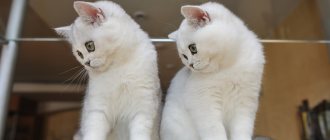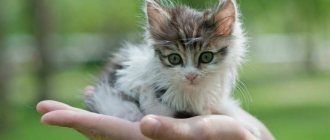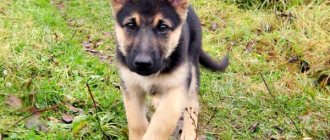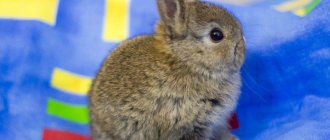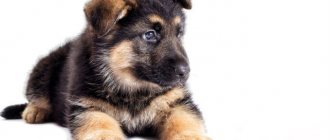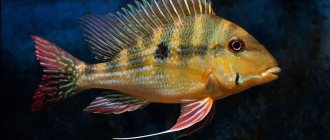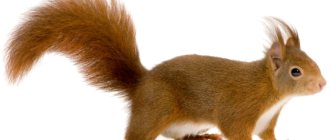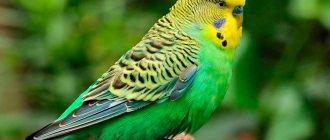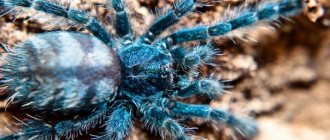Home » Useful Information
In order for your pet to grow healthy and beautiful, you need to choose the right diet for it. And Scottish Fold cats are no exception. Like all purebred animals, they need high-quality feed rich in vitamins, minerals and other beneficial substances. If you decide to get yourself a cat of this breed, be sure to read the recommendations for feeding it.
- 1.1 What to consider when choosing a type of food
1.1.1 Video: basic principles of feeding cats
- 2 Features of food selection
2.1 For kittens
2.1.1 Table: food for Scottish Fold kittens
- 2.1.2 Photo gallery: food for Scottish Fold kittens
- 2.1.3 Video: first feeding of kittens
- 2.1.4 Natural products in a kitten’s diet
- 2.2.1 Table: food for adult Scottish Fold cats
Types of diets
For a kitten, you can choose one of the types of food:
- “Natural” , but this is not food from a person’s table. These are properly selected products that undergo a certain heat treatment. The benefit of such nutrition is that it is as close as possible to natural and natural for animals. It is possible to make your pet’s diet tasty and varied. Disadvantages: wasting time on daily food preparation, insufficient amounts of vitamins and minerals supplied with food. On a natural diet, the kitten will have to be given additional vitamin complexes.
- Industrial food . The best option for both the Scottish Fold and his owner. Dry industrial food contains all the useful substances necessary for the full and harmonious development of a pet. The disadvantage is that good, high-quality food, for example, holistic food, is expensive, but this is what is recommended to be given to the animal.
- Mixed nutrition. As a rule, the combination of industrial food and natural products is not recommended by veterinarians, although many owners often use such a diet. A high concentration of vitamins in food and their presence in natural products can provoke the development of hypervitaminosis in a kitten.
What to feed should be decided immediately when a little Scotsman appears in the house and you should always adhere to the chosen type of diet. Changing the menu from natural to industrial or vice versa has a negative impact on the health of the animal.
To give or not to give kittens raw meat?
Is raw meat allowed for kittens? These debates have been going on between veterinarians and breeders for a long time - there is no common opinion. Some people claim that raw meat is more natural for cats, because in nature cats do not cook meat. Others are categorically against it, because meat sometimes contains parasites and infections, which are not always killed by cold (meat can only be given to cats after three days of freezing). At the same time, cooking kills many beneficial substances - and the diet becomes poorer, sometimes to critical levels. In fact, this discussion is meaningless, since more than a hundred years ago a large-scale experiment was conducted that gave a clear answer to this question.
Rate and share!
Power type
For Scottish Fold kittens, one of the following types of food intake is selected:
- Measured . During the day, the kitten receives food in small portions. The advantage of the regime is that the kitten is well-fed, does not overeat, and the likelihood of obesity and other health problems in the future is reduced. Disadvantage: difficulties for the owner. The feeding schedule is extremely inconvenient for people who are away from home for a long time and cannot regularly (hourly) feed the kitten.
- Continuous mode . There is always food in the bowl. The food is topped up every time the bowl is empty. Disadvantage: There is a risk of obesity. The kitten cannot control the amount of food it eats. The advantage for the owner is that he can be away from home for a long time without worrying about his pet’s diet.
For Scottish Folds, a measured meal schedule is optimal. Given the risks of obesity with a continuous feeding schedule, it is recommended to use it only when absolutely necessary.
How common are food allergies in Scottish Fold cats?
Food allergies are quite common among cats these days. Food allergies usually occur when the Scottish Fold is exposed to specific allergens over a long period of time. An allergy may be, for example, to wheat or corn. If consumed regularly, these additives can disrupt your cat's digestion and lead to the development of food allergies.
Features of natural nutrition
When choosing to feed your pet natural products, you should first find out what can be given to the kitten and what can be harmful to its health.
Authorized Products
Allowed in the diet of a Scottish baby:
- Beef – raw, pre-frozen.
- Chicken - only boiled, without skin, breast is preferable.
- Liver – boiled, given no more than once a week.
- Fish – low-fat varieties: hake, perch or carp. The fish should be boiled, cleaned of bones. It can be given no more than once a week.
- Fermented milk products with minimal fat content : cottage cheese, kefir, fermented baked milk and sour cream.
- Cereals cooked in milk or water : buckwheat, oatmeal and rice. Prepared without salt and sugar. Allowed for use no earlier than 5 months. Cereals are not independent food. They need to be mixed with meat, fish or vegetables.
- Vegetables are sources of carbohydrates necessary for a kitten’s growing, active body. Serve raw, grated, without salt, you can add a little vegetable oil, preferably olive. Recommended vegetables: carrots, cabbage, green beans.
- Fruits – sources of vitamins, but also allergens. You can give them to a kitten, but rarely and in limited quantities. Preference is given to unsweetened varieties of apples, chopped through a grater.
The main rule is the basis of the daily menu - meat.
Prohibited Products
It is strictly forbidden to feed a Scottish Fold kitten:
- homemade and purchased sweets, confectionery;
- fatty meat and fish;
- flavor dishes with salt, spices and sugar;
- pickles and marinades;
- baked, steamed or fried meat;
- smoked meats.
In addition, it is forbidden to give the animal food from the common table, no matter how the pet begs for a treat.
What not to feed the Scots
Scottish cats should not eat foods that contain salt, sugar, or spices. You cannot feed Scottish kittens with heavy cream and sour cream, bread, and marinades. Under no circumstances should you give fish or chicken bones.
You can treat your kids with a small amount of milk if you boil and cool it first. While for adults, dairy products are undesirable. It's all about the large amount of lactose, which older cats cannot digest.
Fish and meat can only be given lean, pre-boiled. Raw foods (meat, eggs) can cause stomach upset.
Industrial feed
When choosing feeding with ready-made food, you need to take into account a number of nuances:
- The production diet must be of high quality. Recommended categories are holistic, super premium and premium. It is necessary to choose food according to the age of the pet.
- Feeding should be carried out strictly according to the schedule, in order to avoid obesity and an excess of vitamin substances in the body of a growing baby.
- Maintain drinking regime. This is important with any type of food, but especially if the kitten eats dry kibble. The kitten should drink at least 150-200 ml of liquid per day.
- For the smallest kittens, it is recommended to choose canned food or jelly. From the age of 6 months, you can switch the animal to large, dry granules.
- It is allowed to feed the kitten dry granules and jelly and canned food, but not at the same meal, without mixing in the same bowl.
Recommended food for Scottish Fold kittens: Royal Canin, Hills, Advence, Matisse.
At what point should you start feeding your kitten?
Despite the fact that the baby can continue to be fed from the mother up to 3 months of age, it is recommended that the first supplementary feeding be done no later than when he is 2 months old. By this age, the animal’s body is ready to learn new eating habits. You should not delay in offering your kitten complementary foods: mother’s milk will no longer fully saturate it by the age of 3 months.
2-month-old Scottish kitten
▲ to contents
Diet by month
The easiest way is to choose industrial - dry and wet food for kittens. The product packaging indicates the age at which it is recommended to consume ready-made food. You need to create a natural diet yourself, taking into account the needs of a kitten at a certain age and the functioning of the digestive system.
1 month
The introduction of the first complementary foods begins. In addition to cat milk or a special formula for feeding a kitten, you can gradually introduce some products into the diet:
- boiled chicken, cut into small pieces;
- cereals cooked in milk diluted with water in equal proportions;
- boiled vegetables and fruits chopped through a grater: cabbage, carrots, apples;
- fermented milk products - the emphasis is on calcined curds.
The food is warmed to room temperature. There should be no food left in the bowl; it is removed after each feeding.
2 months
The active growth of the Scotsman and the appearance of teeth require an expansion of the diet:
- boiled meat - chicken or beef, without salt;
- low-fat fermented milk products;
- boiled cereals;
- raw vegetables;
- chicken egg yolk - boiled or raw, with its addition to meat or cereals.
The meat is cut into pieces, but not very small.
3 months
The kitten’s teeth are already formed, and therefore the meat is cut into fairly large cubes. Sample menu:
- boiled beef or chicken without skin;
- raw vegetables, grated through a medium grater;
- cereals;
- egg yolk;
- low-fat cottage cheese, fermented baked milk;
- fish of lean varieties, but only boneless fillet, pre-frozen or boiled (no more than once a week);
- offal.
Recommended offal: chicken hearts and necks, navels, boiled or frozen. They should be brought to room temperature before serving.
4 months
The diet is gradually and little by little expanding:
- raw, pre-frozen beef, boiled chicken;
- cereals cooked in water;
- 1-2 yolks per week – boiled or raw;
- raw vegetables, fruits;
- dairy products;
- sea fish of lean varieties.
Sea fish should be introduced into the diet gradually, starting with a small piece. This product can cause allergies, so it is important to carefully monitor your pet’s reaction. It is strictly forbidden to give raw fish; it must be boiled.
5 months
At this age, the kitten develops especially actively, so the menu is appropriate:
- raw and boiled meat;
- fermented milk products;
- vegetables and grains;
- lean, low-fat beef broths;
- greens, special sprouted herbs for cats.
If the pet is on a natural diet, starting from 5 months, it can be given special vitamin complexes.
Vaccination
The comprehensive cat vaccine includes three main infectious diseases - panleukopenia (feline distemper), calcivirosis and rhinotracheitis (herpes virus), as well as a fatal disease - rabies. Vaccines that include chlamydia and viral leukemia are also available upon request.
Types of vaccines
For the first time in life, viral diseases are vaccinated twice, with an interval of 21 days. Infections can be vaccinated starting at 8 weeks of age. After a double vaccination, vaccination is carried out once a year, along with rabies. The first time the rabies vaccine is given is at three months, and then once a year.
Important! Even those animals that live in an apartment and do not go outside need to be vaccinated. Infection can easily be brought on by shoes
All viral diseases of cats have a very high mortality rate.
If the cat has never been wormed in its life, then it is better to do it 10 days before vaccination. If, after giving an anthelmintic, vomiting, diarrhea or worms in the feces appear, the treatment against parasites should be repeated and the vaccination should be delayed. In general, an anthelmintic drug should be given once every 3-4 months.
Diet at 6 months: menu for neutered cats
At six months of age, most kittens undergo a castration procedure. From this point on, the pet’s diet needs to be revised, excluding a number of products from it.
After castration, the likelihood of obesity increases, so due attention should be paid to the nutrition of the Scottish Fold.
Features of feeding castrated animals:
- The menu should include foods enriched with fiber and vitamins.
- Complete exclusion of any type of fish from the diet, since it contains phosphorus and magnesium. Regular entry of these elements into the body of a castrated animal increases the likelihood of urolithiasis.
- Be sure to eat porridge. To make cereals tastier, you can add some lean meat to them.
- By-products - in small quantities, no more than once a week.
- Greens and specially sprouted trauma for cats.
- Vegetables are served only raw. Allowed: carrots, cucumbers, cabbage.
- It is recommended to give your pet low-fat beef broths several times a day.
If the Scottish Fold is on a ready-made food, you need to choose only those that are intended for sterilized and neutered animals. The feed must be of appropriate quality. Preference is given to holistic, super and premium classes.
For other kittens that are not castrated or sterilized, the menu remains the same, only the number of meals per day is reduced.
Choosing a place and dishes
Scots of any variety (straight-eared, fold-eared) are not pretentious cats in terms of keeping. All they need for a normal, fulfilling life is attention, affection, and proper care.
The cat should have 2-3 bowls, one of which is deeper, intended for drinking water. Bowls can be made of ceramics, plastic, stainless steel, but not aluminum, as it is toxic to animals.
You can also use dishes with several compartments for feeding. They are placed in a place convenient for the kitten, where no one will disturb him while eating. When eating food, the cat should not experience stress, so if there are other animals in the house, place the bowls on a raised surface (window sill, cabinet).
Advice! Do not place a bowl of water next to food bowls. The Scots prefer to drink away from the place where they eat, which is explained by wild instincts.
After each feeding, wash your cat's bowls with running water without using strong chemicals.
Vitamins and supplements
If a Scotsman is kept on a natural diet, he should receive vitamins and mineral supplements, which can be purchased at a pet store. Up to 6-7 months, during the period of active growth and development, the pet should receive vitamin A, D, E, C, vit. group B, calcium, iodine, magnesium, phosphorus.
Kittens need the essential amino acid taurine to be active. It is contained in high-quality industrial feeds or complex balanced mineral supplements.
Important! If a kitten does not receive the necessary nutrients during the period of active growth and development, this leads to systemic failures in the body, decreased resistance, weakened immunity, problems with the musculoskeletal system, and hair.
Ideally, for Scottish cats, it is best to use a multivitamin complex. If you are in doubt about the choice of vitamin and mineral formulations, consult your veterinarian. The specialist will select a vitamin-mineral complex, medications or supplements, taking into account the diet, age, and general condition of your furry pet.
If the Scotsman receives ready-made food, vitamin supplements are not given. High-quality feed contains all the nutrients. The diet is supplemented with herbs, vegetables, and fruits.
